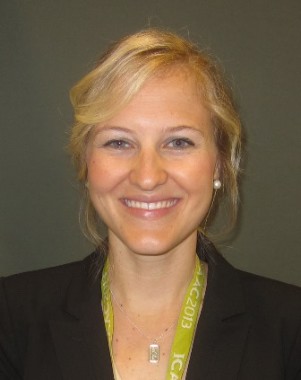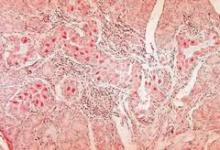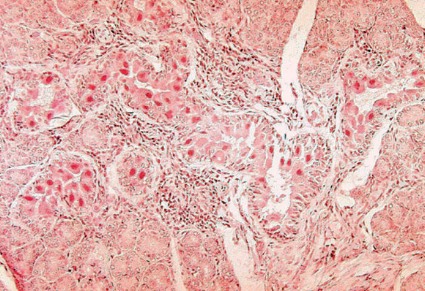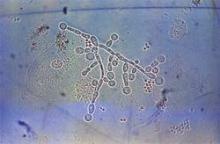User login
M. Alexander Otto began his reporting career early in 1999 covering the pharmaceutical industry for a national pharmacists' magazine and freelancing for the Washington Post and other newspapers. He then joined BNA, now part of Bloomberg News, covering health law and the protection of people and animals in medical research. Alex next worked for the McClatchy Company. Based on his work, Alex won a year-long Knight Science Journalism Fellowship to MIT in 2008-2009. He joined the company shortly thereafter. Alex has a newspaper journalism degree from Syracuse (N.Y.) University and a master's degree in medical science -- a physician assistant degree -- from George Washington University. Alex is based in Seattle.
Catheter UTIs cleared with old-fashioned oxychlorosene flush
DENVER – A 0.05% concentration of the antiseptic sodium oxychlorosene clears urinary tract infections as well as higher concentrations do in patients with urinary catheters, with significantly fewer side effects, a retrospective study showed.
Long used for surgical irrigation, oxychlorosene is a decades-old compound that’s regaining favor for UTIs amid concerns of antibiotic resistance. Typically, 100-150 mL are instilled through the catheter to clear residual urine, then another 100-150 mL, followed by a catheter clamp, to allow the solution to dwell in the bladder for about 10 minutes.
UTI studies dating back to the 1960s tended to use oxychlorosene in concentrations of up to 0.4%. However, after a median of six treatments over a period of 3 days, the investigators in the current study found that the 0.05% solution cleared infection in 58% (58/100) of study patients and curbed infection in 38% (38/100); a 0.2% comparator solution cleared infection in 50% (25/50) and tamed it in 40% (20/50).
The higher concentration caused bladder spasms in two patients and mild burning in two more. Just two patients reported burning sensations in the 0.05% group, and none reported spasms.
Most of the patients had bacterial infections, but some had yeast infections. Cultures in about a third of the 0.05% group grew multidrug-resistant organisms; multidrug-resistant organisms grew out of about half of the 0.2% cultures.
"You have just as good, if not slightly better, efficacy with the 0.05% concentration, and less adverse events. We’ve [switched to 0.05%,] and are still seeing really good clinical outcomes," said lead investigator Andrea Stock, Pharm.D., an infectious disease specialist at Franciscan St. Francis Health in Indianapolis.
"Our in-vitro testing [showed] that oxychlorosene pretty much knocks out everything. We’ve tested it against yeast, multidrug-resistant pseudomonas," Klebsiella pneumoniae carbapenemase–producing bacteria, extended-spectrum beta-lactamase–producing bacteria, and other organisms, she said.
The $2.50 cost per treatment, short duration of therapy, and "positive impact on further development of resistance" all lend support to its use for catheter-related UTIs, she said at the annual Interscience Conference on Antimicrobial Agents and Chemotherapy.
Most in the study had a Foley catheter, but oxychlorosene also worked in patients with suprapubic catheters and those who self-catheterized.
About three-quarters of patients in both groups were on concomitant antibiotics. Patients were about 70 years old on average, and the majority of them were women.
Dr. Stock said she had no relevant financial conflicts.
DENVER – A 0.05% concentration of the antiseptic sodium oxychlorosene clears urinary tract infections as well as higher concentrations do in patients with urinary catheters, with significantly fewer side effects, a retrospective study showed.
Long used for surgical irrigation, oxychlorosene is a decades-old compound that’s regaining favor for UTIs amid concerns of antibiotic resistance. Typically, 100-150 mL are instilled through the catheter to clear residual urine, then another 100-150 mL, followed by a catheter clamp, to allow the solution to dwell in the bladder for about 10 minutes.
UTI studies dating back to the 1960s tended to use oxychlorosene in concentrations of up to 0.4%. However, after a median of six treatments over a period of 3 days, the investigators in the current study found that the 0.05% solution cleared infection in 58% (58/100) of study patients and curbed infection in 38% (38/100); a 0.2% comparator solution cleared infection in 50% (25/50) and tamed it in 40% (20/50).
The higher concentration caused bladder spasms in two patients and mild burning in two more. Just two patients reported burning sensations in the 0.05% group, and none reported spasms.
Most of the patients had bacterial infections, but some had yeast infections. Cultures in about a third of the 0.05% group grew multidrug-resistant organisms; multidrug-resistant organisms grew out of about half of the 0.2% cultures.
"You have just as good, if not slightly better, efficacy with the 0.05% concentration, and less adverse events. We’ve [switched to 0.05%,] and are still seeing really good clinical outcomes," said lead investigator Andrea Stock, Pharm.D., an infectious disease specialist at Franciscan St. Francis Health in Indianapolis.
"Our in-vitro testing [showed] that oxychlorosene pretty much knocks out everything. We’ve tested it against yeast, multidrug-resistant pseudomonas," Klebsiella pneumoniae carbapenemase–producing bacteria, extended-spectrum beta-lactamase–producing bacteria, and other organisms, she said.
The $2.50 cost per treatment, short duration of therapy, and "positive impact on further development of resistance" all lend support to its use for catheter-related UTIs, she said at the annual Interscience Conference on Antimicrobial Agents and Chemotherapy.
Most in the study had a Foley catheter, but oxychlorosene also worked in patients with suprapubic catheters and those who self-catheterized.
About three-quarters of patients in both groups were on concomitant antibiotics. Patients were about 70 years old on average, and the majority of them were women.
Dr. Stock said she had no relevant financial conflicts.
DENVER – A 0.05% concentration of the antiseptic sodium oxychlorosene clears urinary tract infections as well as higher concentrations do in patients with urinary catheters, with significantly fewer side effects, a retrospective study showed.
Long used for surgical irrigation, oxychlorosene is a decades-old compound that’s regaining favor for UTIs amid concerns of antibiotic resistance. Typically, 100-150 mL are instilled through the catheter to clear residual urine, then another 100-150 mL, followed by a catheter clamp, to allow the solution to dwell in the bladder for about 10 minutes.
UTI studies dating back to the 1960s tended to use oxychlorosene in concentrations of up to 0.4%. However, after a median of six treatments over a period of 3 days, the investigators in the current study found that the 0.05% solution cleared infection in 58% (58/100) of study patients and curbed infection in 38% (38/100); a 0.2% comparator solution cleared infection in 50% (25/50) and tamed it in 40% (20/50).
The higher concentration caused bladder spasms in two patients and mild burning in two more. Just two patients reported burning sensations in the 0.05% group, and none reported spasms.
Most of the patients had bacterial infections, but some had yeast infections. Cultures in about a third of the 0.05% group grew multidrug-resistant organisms; multidrug-resistant organisms grew out of about half of the 0.2% cultures.
"You have just as good, if not slightly better, efficacy with the 0.05% concentration, and less adverse events. We’ve [switched to 0.05%,] and are still seeing really good clinical outcomes," said lead investigator Andrea Stock, Pharm.D., an infectious disease specialist at Franciscan St. Francis Health in Indianapolis.
"Our in-vitro testing [showed] that oxychlorosene pretty much knocks out everything. We’ve tested it against yeast, multidrug-resistant pseudomonas," Klebsiella pneumoniae carbapenemase–producing bacteria, extended-spectrum beta-lactamase–producing bacteria, and other organisms, she said.
The $2.50 cost per treatment, short duration of therapy, and "positive impact on further development of resistance" all lend support to its use for catheter-related UTIs, she said at the annual Interscience Conference on Antimicrobial Agents and Chemotherapy.
Most in the study had a Foley catheter, but oxychlorosene also worked in patients with suprapubic catheters and those who self-catheterized.
About three-quarters of patients in both groups were on concomitant antibiotics. Patients were about 70 years old on average, and the majority of them were women.
Dr. Stock said she had no relevant financial conflicts.
AT ICAAC 2013
Antibiotic doses often fall short in ICU hemodialysis patients
DENVER – Antibiotics were dosed too low about 20% of the time in ICU patients on continuous venovenous hemodialysis at the Cleveland Clinic.
Continuous venovenous hemodialysis (CVVHD) artificially improves creatinine clearance; the clinic’s guidelines call for increasing antibiotic doses to compensate.
That didn’t always happen in the 42 Cleveland Clinic patients, and doesn’t always happen elsewhere, said lead investigator Marianna Fedorenko, Pharm.D., a Cleveland Clinic pharmacy resident when the study was done but currently at Barnes-Jewish Hospital in St. Louis.
The clinic has since added an alert to the electronic medical record system to notify prescribers that patients are on CVVHD.
Poor communication was probably to blame. Amid the stress of ICU care, residents, nephrologists, internists, and others may not have known when ordering or adjusting antibiotic doses that patients were on CVVHD. "This is an [issue] that people need to look at it. There are a lot of points during dialysis that are critical for communication. These patients need a closer eye than some other intensive care unit patients," Dr. Fedorenko said.
Most of the patients had failing kidneys and were on pressors and mechanical ventilation; the majority were probably septic. The investigators assessed them at 24 hours for appropriate antibiotic dose. Vancomycin and aminoglycosides – both dosed according to blood levels – were excluded from the analysis.
The 42 patients had a total of 209 antimicrobial days; some were on more than one antibiotic. The median CVVHD flow rate was 26 mL/kg per hour; about half of the patients died during the study period. Overall, "78% [163] of our 209 study days met" CVVHD Cleveland Clinic antibiotic dosing guidelines. The rest were underdosed, Dr. Fedorenko said at the annual Interscience Conference on Antimicrobial Agents and Chemotherapy.
That seemed to be a particular problem with ciprofloxacin, ampicillin/sulbactam, and meropenem. There were fewer problems with Zosyn (piperacillin/tazobactam). "We are more familiar with it," Dr. Fedorenko said.
It took a median of about 20 hours to catch and fix the problems, but some patients remained underdosed throughout CVVHD.
Mistakes were more common on weekdays. "Patients are more likely to be started on CVVHD then, so there’s more room for errors – that’s my hypothesis," she said.
Dr. Fedorenko and the other investigators said they had no financial conflicts of interest.
DENVER – Antibiotics were dosed too low about 20% of the time in ICU patients on continuous venovenous hemodialysis at the Cleveland Clinic.
Continuous venovenous hemodialysis (CVVHD) artificially improves creatinine clearance; the clinic’s guidelines call for increasing antibiotic doses to compensate.
That didn’t always happen in the 42 Cleveland Clinic patients, and doesn’t always happen elsewhere, said lead investigator Marianna Fedorenko, Pharm.D., a Cleveland Clinic pharmacy resident when the study was done but currently at Barnes-Jewish Hospital in St. Louis.
The clinic has since added an alert to the electronic medical record system to notify prescribers that patients are on CVVHD.
Poor communication was probably to blame. Amid the stress of ICU care, residents, nephrologists, internists, and others may not have known when ordering or adjusting antibiotic doses that patients were on CVVHD. "This is an [issue] that people need to look at it. There are a lot of points during dialysis that are critical for communication. These patients need a closer eye than some other intensive care unit patients," Dr. Fedorenko said.
Most of the patients had failing kidneys and were on pressors and mechanical ventilation; the majority were probably septic. The investigators assessed them at 24 hours for appropriate antibiotic dose. Vancomycin and aminoglycosides – both dosed according to blood levels – were excluded from the analysis.
The 42 patients had a total of 209 antimicrobial days; some were on more than one antibiotic. The median CVVHD flow rate was 26 mL/kg per hour; about half of the patients died during the study period. Overall, "78% [163] of our 209 study days met" CVVHD Cleveland Clinic antibiotic dosing guidelines. The rest were underdosed, Dr. Fedorenko said at the annual Interscience Conference on Antimicrobial Agents and Chemotherapy.
That seemed to be a particular problem with ciprofloxacin, ampicillin/sulbactam, and meropenem. There were fewer problems with Zosyn (piperacillin/tazobactam). "We are more familiar with it," Dr. Fedorenko said.
It took a median of about 20 hours to catch and fix the problems, but some patients remained underdosed throughout CVVHD.
Mistakes were more common on weekdays. "Patients are more likely to be started on CVVHD then, so there’s more room for errors – that’s my hypothesis," she said.
Dr. Fedorenko and the other investigators said they had no financial conflicts of interest.
DENVER – Antibiotics were dosed too low about 20% of the time in ICU patients on continuous venovenous hemodialysis at the Cleveland Clinic.
Continuous venovenous hemodialysis (CVVHD) artificially improves creatinine clearance; the clinic’s guidelines call for increasing antibiotic doses to compensate.
That didn’t always happen in the 42 Cleveland Clinic patients, and doesn’t always happen elsewhere, said lead investigator Marianna Fedorenko, Pharm.D., a Cleveland Clinic pharmacy resident when the study was done but currently at Barnes-Jewish Hospital in St. Louis.
The clinic has since added an alert to the electronic medical record system to notify prescribers that patients are on CVVHD.
Poor communication was probably to blame. Amid the stress of ICU care, residents, nephrologists, internists, and others may not have known when ordering or adjusting antibiotic doses that patients were on CVVHD. "This is an [issue] that people need to look at it. There are a lot of points during dialysis that are critical for communication. These patients need a closer eye than some other intensive care unit patients," Dr. Fedorenko said.
Most of the patients had failing kidneys and were on pressors and mechanical ventilation; the majority were probably septic. The investigators assessed them at 24 hours for appropriate antibiotic dose. Vancomycin and aminoglycosides – both dosed according to blood levels – were excluded from the analysis.
The 42 patients had a total of 209 antimicrobial days; some were on more than one antibiotic. The median CVVHD flow rate was 26 mL/kg per hour; about half of the patients died during the study period. Overall, "78% [163] of our 209 study days met" CVVHD Cleveland Clinic antibiotic dosing guidelines. The rest were underdosed, Dr. Fedorenko said at the annual Interscience Conference on Antimicrobial Agents and Chemotherapy.
That seemed to be a particular problem with ciprofloxacin, ampicillin/sulbactam, and meropenem. There were fewer problems with Zosyn (piperacillin/tazobactam). "We are more familiar with it," Dr. Fedorenko said.
It took a median of about 20 hours to catch and fix the problems, but some patients remained underdosed throughout CVVHD.
Mistakes were more common on weekdays. "Patients are more likely to be started on CVVHD then, so there’s more room for errors – that’s my hypothesis," she said.
Dr. Fedorenko and the other investigators said they had no financial conflicts of interest.
AT ICAAC 2013
Major finding: Antibiotics were underdosed in 46 of 209 (22%) treatment days in 42 continuous venovenous hemodialysis patients at the Cleveland Clinic in Ohio.
Data Source: Chart review.
Disclosures: The investigators said they had no disclosures.
Beta-lactams worth the risk in bacteremic patients with penicillin allergies
DENVER – Penicillin allergies are no reason to forego empiric beta-lactam therapy in patients whose blood is infected with gram-negative bacilli, according to results from a retrospective study.
The penicillin derivatives are "worth the risk," said lead investigator Meghan Jeffres, Pharm.D., of the department of pharmacy practice at Roseman University of Health Sciences in Henderson, Nev.
None of 59 patients with documented penicillin reactions had an allergic reaction to the antibiotics, which were most often cephalosporins and carbapenems. A sixtieth patient had a non-IgE-mediated rash after failing ciprofloxacin – a non-beta-lactam (NBL) – and being switched to cefcapene, she reported at the annual Interscience Conference on Antimicrobial Agents and Chemotherapy.
Meanwhile, 24% (6 of 25) of the patients who were initially treated with an NBL, but only 15.3% (9/59) of patients who received beta-lactam (BL) empiric therapy, died from bacteremia complications; the mortality difference was driven by a lack of appropriate empiric therapy in the NBL group (52% vs. 18.6%).
BLs are already considered first-line for gram-negative bloodstream infections, in part because they are safer than fluoroquinolones, aminoglycosides, and other NBL options. Still, when a patient has a penicillin allergy, "clinicians are faced with a dilemma. ‘Do I risk the allergic reaction and give a beta-lactam, or do I avoid the risk of developing an allergic reaction and give a non-beta-lactam, even though it might be inferior clinically’," Dr. Jeffres explained.
It’s an important question because there are no randomized controlled trials to guide practice, she said at the conference.
The findings were part of a larger study that compared BL empiric therapy in 494 bacteremic patients with NBL empiric therapy in 104 others.
Compared with the NBL group, hospital stays were significantly shorter in patients treated with a BL (42 days vs. 28 days), rates of clinical failure were lower (33% vs. 23%), and mortality rates were reduced (20% vs. 13%).
"Only 60% of patients started empirically on [an NBL] ended up having an antibiotic that was active against their infecting pathogen," while the offending organism was susceptible to empiric therapy in more than 70% of BL patients. "The choice of a [BL] may only be superior based on the increased likelihood of having activity against the infecting pathogen," Dr. Jeffres said.
In addition to empiric BL therapy, mechanical ventilation at the start of antibiotics and a higher APACHE II (Acute Physiology and Chronic Health Evaluation II) score were both independent risk factors for clinical failure on multivariate regression, she reported.
BL patients were more likely to be immunosuppressed, but the two groups were otherwise well matched for the presence of trauma, cirrhosis, and other comorbidities. Patients were in their mid-50s, on average, in both groups.
Dr. Jeffres said she had no financial conflicts of interest.
DENVER – Penicillin allergies are no reason to forego empiric beta-lactam therapy in patients whose blood is infected with gram-negative bacilli, according to results from a retrospective study.
The penicillin derivatives are "worth the risk," said lead investigator Meghan Jeffres, Pharm.D., of the department of pharmacy practice at Roseman University of Health Sciences in Henderson, Nev.
None of 59 patients with documented penicillin reactions had an allergic reaction to the antibiotics, which were most often cephalosporins and carbapenems. A sixtieth patient had a non-IgE-mediated rash after failing ciprofloxacin – a non-beta-lactam (NBL) – and being switched to cefcapene, she reported at the annual Interscience Conference on Antimicrobial Agents and Chemotherapy.
Meanwhile, 24% (6 of 25) of the patients who were initially treated with an NBL, but only 15.3% (9/59) of patients who received beta-lactam (BL) empiric therapy, died from bacteremia complications; the mortality difference was driven by a lack of appropriate empiric therapy in the NBL group (52% vs. 18.6%).
BLs are already considered first-line for gram-negative bloodstream infections, in part because they are safer than fluoroquinolones, aminoglycosides, and other NBL options. Still, when a patient has a penicillin allergy, "clinicians are faced with a dilemma. ‘Do I risk the allergic reaction and give a beta-lactam, or do I avoid the risk of developing an allergic reaction and give a non-beta-lactam, even though it might be inferior clinically’," Dr. Jeffres explained.
It’s an important question because there are no randomized controlled trials to guide practice, she said at the conference.
The findings were part of a larger study that compared BL empiric therapy in 494 bacteremic patients with NBL empiric therapy in 104 others.
Compared with the NBL group, hospital stays were significantly shorter in patients treated with a BL (42 days vs. 28 days), rates of clinical failure were lower (33% vs. 23%), and mortality rates were reduced (20% vs. 13%).
"Only 60% of patients started empirically on [an NBL] ended up having an antibiotic that was active against their infecting pathogen," while the offending organism was susceptible to empiric therapy in more than 70% of BL patients. "The choice of a [BL] may only be superior based on the increased likelihood of having activity against the infecting pathogen," Dr. Jeffres said.
In addition to empiric BL therapy, mechanical ventilation at the start of antibiotics and a higher APACHE II (Acute Physiology and Chronic Health Evaluation II) score were both independent risk factors for clinical failure on multivariate regression, she reported.
BL patients were more likely to be immunosuppressed, but the two groups were otherwise well matched for the presence of trauma, cirrhosis, and other comorbidities. Patients were in their mid-50s, on average, in both groups.
Dr. Jeffres said she had no financial conflicts of interest.
DENVER – Penicillin allergies are no reason to forego empiric beta-lactam therapy in patients whose blood is infected with gram-negative bacilli, according to results from a retrospective study.
The penicillin derivatives are "worth the risk," said lead investigator Meghan Jeffres, Pharm.D., of the department of pharmacy practice at Roseman University of Health Sciences in Henderson, Nev.
None of 59 patients with documented penicillin reactions had an allergic reaction to the antibiotics, which were most often cephalosporins and carbapenems. A sixtieth patient had a non-IgE-mediated rash after failing ciprofloxacin – a non-beta-lactam (NBL) – and being switched to cefcapene, she reported at the annual Interscience Conference on Antimicrobial Agents and Chemotherapy.
Meanwhile, 24% (6 of 25) of the patients who were initially treated with an NBL, but only 15.3% (9/59) of patients who received beta-lactam (BL) empiric therapy, died from bacteremia complications; the mortality difference was driven by a lack of appropriate empiric therapy in the NBL group (52% vs. 18.6%).
BLs are already considered first-line for gram-negative bloodstream infections, in part because they are safer than fluoroquinolones, aminoglycosides, and other NBL options. Still, when a patient has a penicillin allergy, "clinicians are faced with a dilemma. ‘Do I risk the allergic reaction and give a beta-lactam, or do I avoid the risk of developing an allergic reaction and give a non-beta-lactam, even though it might be inferior clinically’," Dr. Jeffres explained.
It’s an important question because there are no randomized controlled trials to guide practice, she said at the conference.
The findings were part of a larger study that compared BL empiric therapy in 494 bacteremic patients with NBL empiric therapy in 104 others.
Compared with the NBL group, hospital stays were significantly shorter in patients treated with a BL (42 days vs. 28 days), rates of clinical failure were lower (33% vs. 23%), and mortality rates were reduced (20% vs. 13%).
"Only 60% of patients started empirically on [an NBL] ended up having an antibiotic that was active against their infecting pathogen," while the offending organism was susceptible to empiric therapy in more than 70% of BL patients. "The choice of a [BL] may only be superior based on the increased likelihood of having activity against the infecting pathogen," Dr. Jeffres said.
In addition to empiric BL therapy, mechanical ventilation at the start of antibiotics and a higher APACHE II (Acute Physiology and Chronic Health Evaluation II) score were both independent risk factors for clinical failure on multivariate regression, she reported.
BL patients were more likely to be immunosuppressed, but the two groups were otherwise well matched for the presence of trauma, cirrhosis, and other comorbidities. Patients were in their mid-50s, on average, in both groups.
Dr. Jeffres said she had no financial conflicts of interest.
AT ICAAC 2013
Major finding: Not one of 59 bacteremic patients with a documented penicillin allergy had an allergic reaction to empiric beta-lactim treatment.
Data source: Retrospective cohort study in 598 bacteremic people
Disclosures: Dr. Jeffres said she had no financial conflicts of interest.
Real-world SVR rate about 33% with hepatitis C triple therapy
DENVER – Only one-third of a group of patients with hepatitis C achieved a sustained virologic response when a protease inhibitor was added to standard ribavirin and interferon dual therapy, a real-world finding that flies in the face of reported response rates closer to 90%, according to Dr. Arpita Sheth who presented a poster at the Interscience Conference on Antimicrobial Agents and Chemotherapy.
Of 42 patients at the Veterans Affairs hospital in East Orange, N.J., who started on triple therapy with the protease inhibitor boceprevir, 9 had to drop out because of previously recognized adverse events, including thrombocytopenia, neutropenia, anemia, and depression. Five other patients did not comply with treatment, and treatment failed in 10. About half of the patients were new to therapy and the rest either non- responders to dual-therapy or triple-therapy relapsers.
Of the 18 who completed treatment, 9 achieved SVR [sustained virological response] at 3 months and 5 at 6 months. The four remaining patients relapsed.
"The incremental gain of adding protease inhibitors to the traditional regimen of ribavirin and interferon has a potential SVR rate of 33% (14/42) among retreaters and naive-to-treatment patients. Treatment should be evaluated at a more realistic number of 33% success [rather] than the 80%-90% SVR rate so frequently quoted from the FDA registration trials," concluded Dr. Sheth, a fellow at Rutgers New Jersey Medical School in Newark, in her presentation.
The real-world rate is lower, at least in Newark’s VA population. To avoid disappointment, "we should always make our patients aware of that; we’ve seen a lot of patients get upset that they didn’t really get cured" with triple therapy, she said at the meeting. The findings from the study conducted by Dr. Sheth and her associates was published earlier (N. Engl. J. Med. 2011;364:1207-17).
The results probably had something to do with "the patient population we had. They do have some underlying history that includes depression, alcohol use, drug use, and a lot of other things. Even though [most] said they were compliant, I don’t think [compliance was] what they reported," Dr. Sheth said.
About a third of patients in the study required erythropoietin to maintain their hemoglobin at 10 g/dL or higher while on triple therapy.
Dr. Sheth and her team reported that they have no disclosures.
DENVER – Only one-third of a group of patients with hepatitis C achieved a sustained virologic response when a protease inhibitor was added to standard ribavirin and interferon dual therapy, a real-world finding that flies in the face of reported response rates closer to 90%, according to Dr. Arpita Sheth who presented a poster at the Interscience Conference on Antimicrobial Agents and Chemotherapy.
Of 42 patients at the Veterans Affairs hospital in East Orange, N.J., who started on triple therapy with the protease inhibitor boceprevir, 9 had to drop out because of previously recognized adverse events, including thrombocytopenia, neutropenia, anemia, and depression. Five other patients did not comply with treatment, and treatment failed in 10. About half of the patients were new to therapy and the rest either non- responders to dual-therapy or triple-therapy relapsers.
Of the 18 who completed treatment, 9 achieved SVR [sustained virological response] at 3 months and 5 at 6 months. The four remaining patients relapsed.
"The incremental gain of adding protease inhibitors to the traditional regimen of ribavirin and interferon has a potential SVR rate of 33% (14/42) among retreaters and naive-to-treatment patients. Treatment should be evaluated at a more realistic number of 33% success [rather] than the 80%-90% SVR rate so frequently quoted from the FDA registration trials," concluded Dr. Sheth, a fellow at Rutgers New Jersey Medical School in Newark, in her presentation.
The real-world rate is lower, at least in Newark’s VA population. To avoid disappointment, "we should always make our patients aware of that; we’ve seen a lot of patients get upset that they didn’t really get cured" with triple therapy, she said at the meeting. The findings from the study conducted by Dr. Sheth and her associates was published earlier (N. Engl. J. Med. 2011;364:1207-17).
The results probably had something to do with "the patient population we had. They do have some underlying history that includes depression, alcohol use, drug use, and a lot of other things. Even though [most] said they were compliant, I don’t think [compliance was] what they reported," Dr. Sheth said.
About a third of patients in the study required erythropoietin to maintain their hemoglobin at 10 g/dL or higher while on triple therapy.
Dr. Sheth and her team reported that they have no disclosures.
DENVER – Only one-third of a group of patients with hepatitis C achieved a sustained virologic response when a protease inhibitor was added to standard ribavirin and interferon dual therapy, a real-world finding that flies in the face of reported response rates closer to 90%, according to Dr. Arpita Sheth who presented a poster at the Interscience Conference on Antimicrobial Agents and Chemotherapy.
Of 42 patients at the Veterans Affairs hospital in East Orange, N.J., who started on triple therapy with the protease inhibitor boceprevir, 9 had to drop out because of previously recognized adverse events, including thrombocytopenia, neutropenia, anemia, and depression. Five other patients did not comply with treatment, and treatment failed in 10. About half of the patients were new to therapy and the rest either non- responders to dual-therapy or triple-therapy relapsers.
Of the 18 who completed treatment, 9 achieved SVR [sustained virological response] at 3 months and 5 at 6 months. The four remaining patients relapsed.
"The incremental gain of adding protease inhibitors to the traditional regimen of ribavirin and interferon has a potential SVR rate of 33% (14/42) among retreaters and naive-to-treatment patients. Treatment should be evaluated at a more realistic number of 33% success [rather] than the 80%-90% SVR rate so frequently quoted from the FDA registration trials," concluded Dr. Sheth, a fellow at Rutgers New Jersey Medical School in Newark, in her presentation.
The real-world rate is lower, at least in Newark’s VA population. To avoid disappointment, "we should always make our patients aware of that; we’ve seen a lot of patients get upset that they didn’t really get cured" with triple therapy, she said at the meeting. The findings from the study conducted by Dr. Sheth and her associates was published earlier (N. Engl. J. Med. 2011;364:1207-17).
The results probably had something to do with "the patient population we had. They do have some underlying history that includes depression, alcohol use, drug use, and a lot of other things. Even though [most] said they were compliant, I don’t think [compliance was] what they reported," Dr. Sheth said.
About a third of patients in the study required erythropoietin to maintain their hemoglobin at 10 g/dL or higher while on triple therapy.
Dr. Sheth and her team reported that they have no disclosures.
AT ICAAC 2013
Major finding: Of 42 patients with hepatitis C who started on triple therapy with boceprevir, ribavirin, and interferon, 18 completed treatment and 14 (33%) achieved a sustained virologic responses.
Data Source: Retrospective chart review of VA patients
Disclosures: The investigators have no disclosures
Immune globulin may not block intrauterine CMV transmission
BERNALILLO, N.M. – Results were mixed in an Italian trial of hyperimmune globulin to block intrauterine transmission of cytomegalovirus, an investigation that was largely an attempt to replicate a well-known but uncontrolled 2005 study in which the agent appeared to do just that.
Thirty percent of women (18/61) with primary cytomegalovirus (CMV) infection given intravenous anti-CMV hyperimmune globulin (Cytotect, Biotest) until gestational week 36 – or CMV-positive amniocentesis – passed the virus on to their fetuses or newborns. The transmission rate was 44% (27/62) in the trial’s saline-placebo arm, but the difference was not statistically significant (95% P = .13).
Hyperimmune globulin–treated women also had a higher incidence of serious obstetric adverse events, including preeclampsia and fetal growth restriction (P =.06). Preterm delivery was the most frequent problem; there was one preterm delivery of an infected infant in the placebo group, but there were seven in the hyperimmune globulin (HIG) group – six noninfected infants and one infected infant.
"In some cases, prematurity was rather severe," but the medical records of the women haven’t been reviewed yet to see if they had risk factors for early delivery, said lead investigator Dr. Maria Revello of the IRCCS Policlinico San Matteo in Pavia, Italy.
Overall, "the safety and efficacy of HIG for the prevention of [CMV] transmission remains to be established in phase III studies. The jury is still out," she said at the annual meeting of the Infectious Diseases Society for Obstetrics and Gynecology. One such trial is underway in the United States, with an enrollment goal of 800 women.
There were no significant differences in virus antibody kinetics, weeks of gestation at enrollment, blood viral loads, and other factors among women who transmitted the virus in either trial arm. Likewise, there were no significant differences in amniotic viral loads, ultrasound findings, clinical birth outcomes, and other factors between infected fetuses and newborns in the two arms.
The results seem to be at odds with the 2005 project and its finding that HIG decreased intrauterine transmission from 40% to 16% (N. Engl. J. Med. 2005;353:1350-62).
That study "raised a lot of interest and a lot of expectations," but because it wasn’t a randomized controlled trial, the authors called for one in their conclusions. "That’s what we did," Dr. Revello said.
Her team used the same drug at the same dosage, 100 U/kg monthly. About 60 women were in each arm because that was the number needed to demonstrate a significant reduction in transmission from 40% to 16%. Enrollment was limited to those who picked up the infection between 5 and 26 weeks of gestation, because that’s when the rate of transmission is thought to be 40%.
The "results are actually quite encouraging because they do suggest there’s efficacy," said Dr. Stuart Adler, an author on the earlier paper, after hearing Dr. Revello’s presentation.
"Your study was slightly underpowered, but it was not significantly different in terms of efficacy rate. If you do a logistic regression of the two studies, it looks like the efficacy would be about 50%, probably because a lot of those babies were infected prior to receiving Cytotect," said Dr. Adler, a pediatric infectious disease specialist at Virginia Commonwealth University in Richmond.
Even so, until there is a proven treatment to block intrauterine CMV transmission, the best way to prevent it is to identify women who are not infected and teach them how to avoid the virus while pregnant, Dr. Revello said.
The virus is usually picked up during pregnancy through sexual contact or contact with the urine or saliva of young infected children.
Dr. Revello and Dr. Adler reported no relevant financial disclosures. The study was funded by the Italian government.
BERNALILLO, N.M. – Results were mixed in an Italian trial of hyperimmune globulin to block intrauterine transmission of cytomegalovirus, an investigation that was largely an attempt to replicate a well-known but uncontrolled 2005 study in which the agent appeared to do just that.
Thirty percent of women (18/61) with primary cytomegalovirus (CMV) infection given intravenous anti-CMV hyperimmune globulin (Cytotect, Biotest) until gestational week 36 – or CMV-positive amniocentesis – passed the virus on to their fetuses or newborns. The transmission rate was 44% (27/62) in the trial’s saline-placebo arm, but the difference was not statistically significant (95% P = .13).
Hyperimmune globulin–treated women also had a higher incidence of serious obstetric adverse events, including preeclampsia and fetal growth restriction (P =.06). Preterm delivery was the most frequent problem; there was one preterm delivery of an infected infant in the placebo group, but there were seven in the hyperimmune globulin (HIG) group – six noninfected infants and one infected infant.
"In some cases, prematurity was rather severe," but the medical records of the women haven’t been reviewed yet to see if they had risk factors for early delivery, said lead investigator Dr. Maria Revello of the IRCCS Policlinico San Matteo in Pavia, Italy.
Overall, "the safety and efficacy of HIG for the prevention of [CMV] transmission remains to be established in phase III studies. The jury is still out," she said at the annual meeting of the Infectious Diseases Society for Obstetrics and Gynecology. One such trial is underway in the United States, with an enrollment goal of 800 women.
There were no significant differences in virus antibody kinetics, weeks of gestation at enrollment, blood viral loads, and other factors among women who transmitted the virus in either trial arm. Likewise, there were no significant differences in amniotic viral loads, ultrasound findings, clinical birth outcomes, and other factors between infected fetuses and newborns in the two arms.
The results seem to be at odds with the 2005 project and its finding that HIG decreased intrauterine transmission from 40% to 16% (N. Engl. J. Med. 2005;353:1350-62).
That study "raised a lot of interest and a lot of expectations," but because it wasn’t a randomized controlled trial, the authors called for one in their conclusions. "That’s what we did," Dr. Revello said.
Her team used the same drug at the same dosage, 100 U/kg monthly. About 60 women were in each arm because that was the number needed to demonstrate a significant reduction in transmission from 40% to 16%. Enrollment was limited to those who picked up the infection between 5 and 26 weeks of gestation, because that’s when the rate of transmission is thought to be 40%.
The "results are actually quite encouraging because they do suggest there’s efficacy," said Dr. Stuart Adler, an author on the earlier paper, after hearing Dr. Revello’s presentation.
"Your study was slightly underpowered, but it was not significantly different in terms of efficacy rate. If you do a logistic regression of the two studies, it looks like the efficacy would be about 50%, probably because a lot of those babies were infected prior to receiving Cytotect," said Dr. Adler, a pediatric infectious disease specialist at Virginia Commonwealth University in Richmond.
Even so, until there is a proven treatment to block intrauterine CMV transmission, the best way to prevent it is to identify women who are not infected and teach them how to avoid the virus while pregnant, Dr. Revello said.
The virus is usually picked up during pregnancy through sexual contact or contact with the urine or saliva of young infected children.
Dr. Revello and Dr. Adler reported no relevant financial disclosures. The study was funded by the Italian government.
BERNALILLO, N.M. – Results were mixed in an Italian trial of hyperimmune globulin to block intrauterine transmission of cytomegalovirus, an investigation that was largely an attempt to replicate a well-known but uncontrolled 2005 study in which the agent appeared to do just that.
Thirty percent of women (18/61) with primary cytomegalovirus (CMV) infection given intravenous anti-CMV hyperimmune globulin (Cytotect, Biotest) until gestational week 36 – or CMV-positive amniocentesis – passed the virus on to their fetuses or newborns. The transmission rate was 44% (27/62) in the trial’s saline-placebo arm, but the difference was not statistically significant (95% P = .13).
Hyperimmune globulin–treated women also had a higher incidence of serious obstetric adverse events, including preeclampsia and fetal growth restriction (P =.06). Preterm delivery was the most frequent problem; there was one preterm delivery of an infected infant in the placebo group, but there were seven in the hyperimmune globulin (HIG) group – six noninfected infants and one infected infant.
"In some cases, prematurity was rather severe," but the medical records of the women haven’t been reviewed yet to see if they had risk factors for early delivery, said lead investigator Dr. Maria Revello of the IRCCS Policlinico San Matteo in Pavia, Italy.
Overall, "the safety and efficacy of HIG for the prevention of [CMV] transmission remains to be established in phase III studies. The jury is still out," she said at the annual meeting of the Infectious Diseases Society for Obstetrics and Gynecology. One such trial is underway in the United States, with an enrollment goal of 800 women.
There were no significant differences in virus antibody kinetics, weeks of gestation at enrollment, blood viral loads, and other factors among women who transmitted the virus in either trial arm. Likewise, there were no significant differences in amniotic viral loads, ultrasound findings, clinical birth outcomes, and other factors between infected fetuses and newborns in the two arms.
The results seem to be at odds with the 2005 project and its finding that HIG decreased intrauterine transmission from 40% to 16% (N. Engl. J. Med. 2005;353:1350-62).
That study "raised a lot of interest and a lot of expectations," but because it wasn’t a randomized controlled trial, the authors called for one in their conclusions. "That’s what we did," Dr. Revello said.
Her team used the same drug at the same dosage, 100 U/kg monthly. About 60 women were in each arm because that was the number needed to demonstrate a significant reduction in transmission from 40% to 16%. Enrollment was limited to those who picked up the infection between 5 and 26 weeks of gestation, because that’s when the rate of transmission is thought to be 40%.
The "results are actually quite encouraging because they do suggest there’s efficacy," said Dr. Stuart Adler, an author on the earlier paper, after hearing Dr. Revello’s presentation.
"Your study was slightly underpowered, but it was not significantly different in terms of efficacy rate. If you do a logistic regression of the two studies, it looks like the efficacy would be about 50%, probably because a lot of those babies were infected prior to receiving Cytotect," said Dr. Adler, a pediatric infectious disease specialist at Virginia Commonwealth University in Richmond.
Even so, until there is a proven treatment to block intrauterine CMV transmission, the best way to prevent it is to identify women who are not infected and teach them how to avoid the virus while pregnant, Dr. Revello said.
The virus is usually picked up during pregnancy through sexual contact or contact with the urine or saliva of young infected children.
Dr. Revello and Dr. Adler reported no relevant financial disclosures. The study was funded by the Italian government.
AT IDSOG
Major finding: Thirty percent of women given intravenous anti-CMV hyperimmune globulin, but 44% of those given a saline placebo, passed CMV on to their fetuses or newborns. The difference was not statistically significant.
Data Source: A randomized, double blind, multicenter phase II trial involving 123 pregnant women with primary CMV infection
Disclosures: Dr. Revello and Dr. Adler reported no relevant financial disclosures. The Italian government funded the project.
New Candida species isolated in U.S.
DENVER – Candida africana, a species previously unreported in the United States, has been isolated from three women from North Carolina and one from Virginia.
Identified ultimately by sequencing, the organism was first isolated from the Virginia woman’s urine, and then, over the course of a few months, from endometrial biopsy samples from one of the North Carolina women, and vaginal discharge swabs from the two others. The women were aged 15-35 years; one may have been an immigrant. None tested positive for C. albicans.
The good news is that the isolates were susceptible to standard azole therapy and other treatments. "It’s a little bit different from C. albicans because it becomes resistant faster, but [intravaginal] fluconazole should work just fine for" yeast infections, said lead investigator Kevin Hazen, Ph.D., director of clinical microbiology at the Duke University Health System in Durham, N.C.
Even so, "you want to tell your laboratory to be on the lookout for this organism. We need to get much better information about how prevalent it is in the United States, because with that information we can investigate why this supposedly low pathogenic organism is out-competing albicans in [some] women and causing disease. We don’t know why these specific women are getting it or how significant it is in terms of causing recurrent yeast infections or subsequent disease," he said at the annual Interscience Conference on Antimicrobial Agents and Chemotherapy.
C. africana may well be endemic in the United States at this point, but it has been unrecognized until now because laboratories have reported it simply as "yeast, not Candida albicans."
"This organism kind of looks like albicans "on wet mount and is also germ tube positive. "Most labs will stop testing at that point," Dr. Hazen said.
But unlike C. albicans, C. africana doesn’t produce chlamydospores, doesn’t grow at 42° C, tests negative for L-proline aminopeptidase activity, and grows in rough colonies on bird seed agar, instead of smooth ones.
C. africana was first isolated on vaginal swabs from women in Madagascar and Angola and described in 1995; it’s since been isolated in Europe, Japan, Chile, and Saudi Arabia, almost exclusively from the female genitourinary tract, but on blood culture in at least one case.
Dr. Hazen said he has no disclosures.
DENVER – Candida africana, a species previously unreported in the United States, has been isolated from three women from North Carolina and one from Virginia.
Identified ultimately by sequencing, the organism was first isolated from the Virginia woman’s urine, and then, over the course of a few months, from endometrial biopsy samples from one of the North Carolina women, and vaginal discharge swabs from the two others. The women were aged 15-35 years; one may have been an immigrant. None tested positive for C. albicans.
The good news is that the isolates were susceptible to standard azole therapy and other treatments. "It’s a little bit different from C. albicans because it becomes resistant faster, but [intravaginal] fluconazole should work just fine for" yeast infections, said lead investigator Kevin Hazen, Ph.D., director of clinical microbiology at the Duke University Health System in Durham, N.C.
Even so, "you want to tell your laboratory to be on the lookout for this organism. We need to get much better information about how prevalent it is in the United States, because with that information we can investigate why this supposedly low pathogenic organism is out-competing albicans in [some] women and causing disease. We don’t know why these specific women are getting it or how significant it is in terms of causing recurrent yeast infections or subsequent disease," he said at the annual Interscience Conference on Antimicrobial Agents and Chemotherapy.
C. africana may well be endemic in the United States at this point, but it has been unrecognized until now because laboratories have reported it simply as "yeast, not Candida albicans."
"This organism kind of looks like albicans "on wet mount and is also germ tube positive. "Most labs will stop testing at that point," Dr. Hazen said.
But unlike C. albicans, C. africana doesn’t produce chlamydospores, doesn’t grow at 42° C, tests negative for L-proline aminopeptidase activity, and grows in rough colonies on bird seed agar, instead of smooth ones.
C. africana was first isolated on vaginal swabs from women in Madagascar and Angola and described in 1995; it’s since been isolated in Europe, Japan, Chile, and Saudi Arabia, almost exclusively from the female genitourinary tract, but on blood culture in at least one case.
Dr. Hazen said he has no disclosures.
DENVER – Candida africana, a species previously unreported in the United States, has been isolated from three women from North Carolina and one from Virginia.
Identified ultimately by sequencing, the organism was first isolated from the Virginia woman’s urine, and then, over the course of a few months, from endometrial biopsy samples from one of the North Carolina women, and vaginal discharge swabs from the two others. The women were aged 15-35 years; one may have been an immigrant. None tested positive for C. albicans.
The good news is that the isolates were susceptible to standard azole therapy and other treatments. "It’s a little bit different from C. albicans because it becomes resistant faster, but [intravaginal] fluconazole should work just fine for" yeast infections, said lead investigator Kevin Hazen, Ph.D., director of clinical microbiology at the Duke University Health System in Durham, N.C.
Even so, "you want to tell your laboratory to be on the lookout for this organism. We need to get much better information about how prevalent it is in the United States, because with that information we can investigate why this supposedly low pathogenic organism is out-competing albicans in [some] women and causing disease. We don’t know why these specific women are getting it or how significant it is in terms of causing recurrent yeast infections or subsequent disease," he said at the annual Interscience Conference on Antimicrobial Agents and Chemotherapy.
C. africana may well be endemic in the United States at this point, but it has been unrecognized until now because laboratories have reported it simply as "yeast, not Candida albicans."
"This organism kind of looks like albicans "on wet mount and is also germ tube positive. "Most labs will stop testing at that point," Dr. Hazen said.
But unlike C. albicans, C. africana doesn’t produce chlamydospores, doesn’t grow at 42° C, tests negative for L-proline aminopeptidase activity, and grows in rough colonies on bird seed agar, instead of smooth ones.
C. africana was first isolated on vaginal swabs from women in Madagascar and Angola and described in 1995; it’s since been isolated in Europe, Japan, Chile, and Saudi Arabia, almost exclusively from the female genitourinary tract, but on blood culture in at least one case.
Dr. Hazen said he has no disclosures.
AT ICAAC 2013
Major finding: Unlike C. albicans, C. africana doesn’t produce chlamydospores, doesn’t grow at 42°C, tests negative for L-proline aminopeptidase activity, and grows in rough colonies on bird seed agar, instead of smooth ones.
Data Source: Analysis of isolates from four women.
Disclosures: The lead investigator has no disclosures.
ECG leads were misplaced in 3% of children in a single-center study
VANCOUVER, B.C. – ECG leads were misplaced in 3% of 1,470 pediatric ECGs, based on a review study performed at the Ochsner Medical Center in New Orleans.
Crisscrossed leads were seen in 45 studies; 19 were left arm/left leg reversals, 15 were left arm/right arm reversals, 8 were precordial misplacements, and 3 were right arm/right leg reversals. The majority, 31 of the 45 errors, happened in the pediatric outpatient clinic. Six occurred in the emergency department, and eight in the hospital. While the placements were done by nurses and technicians, pediatric electrophysiologists and other physicians signed off on the reports without catching the mistakes.
Part of the problem "is the high number of ECGs that you have to read, the low reimbursement rate, and people talking" over your shoulder expecting a quick signature because most pediatric ECGs turn up nothing, said senior investigator Dr. Christopher Snyder, a pediatric cardiologist and electrophysiologist formerly at Ochsner, but now with Case Western Reserve University in Cleveland. "Small chests can also make lead placement tricky; the kids were 10.4 years old on average."
That being said, Dr. Snyder said he reviewed all of these cases "in an hour and 20 minutes. You can pick these out pretty easily" from polarity reversals and other signs.
"I think we need to take maybe 3 seconds to interpret ECGs, as opposed to 1," he remarked.
Dr. Snyder undertook the review after an ECG error resulted in a child being sent to the cath lab at Ochsner with a presumed MI.
"I came in on a Saturday morning and found out that this kid was in the cath lab, and he’d already had his coronaries shot. I ran down there and said ‘this is lead reversal,’ but they didn’t buy into it," even after his coronaries turned out to be normal, Dr. Snyder said. The leads were misplaced; the nurse didn’t understand that "left and right are reversed when you’re looking at someone."
In general, lead misplacement doesn’t result in that much harm, but it does lead to echoes, Holters, and follow-up visits that wouldn’t have happened if ECGs had been done right in the first place, he said.
Dr. Snyder said he had no relevant disclosures.
VANCOUVER, B.C. – ECG leads were misplaced in 3% of 1,470 pediatric ECGs, based on a review study performed at the Ochsner Medical Center in New Orleans.
Crisscrossed leads were seen in 45 studies; 19 were left arm/left leg reversals, 15 were left arm/right arm reversals, 8 were precordial misplacements, and 3 were right arm/right leg reversals. The majority, 31 of the 45 errors, happened in the pediatric outpatient clinic. Six occurred in the emergency department, and eight in the hospital. While the placements were done by nurses and technicians, pediatric electrophysiologists and other physicians signed off on the reports without catching the mistakes.
Part of the problem "is the high number of ECGs that you have to read, the low reimbursement rate, and people talking" over your shoulder expecting a quick signature because most pediatric ECGs turn up nothing, said senior investigator Dr. Christopher Snyder, a pediatric cardiologist and electrophysiologist formerly at Ochsner, but now with Case Western Reserve University in Cleveland. "Small chests can also make lead placement tricky; the kids were 10.4 years old on average."
That being said, Dr. Snyder said he reviewed all of these cases "in an hour and 20 minutes. You can pick these out pretty easily" from polarity reversals and other signs.
"I think we need to take maybe 3 seconds to interpret ECGs, as opposed to 1," he remarked.
Dr. Snyder undertook the review after an ECG error resulted in a child being sent to the cath lab at Ochsner with a presumed MI.
"I came in on a Saturday morning and found out that this kid was in the cath lab, and he’d already had his coronaries shot. I ran down there and said ‘this is lead reversal,’ but they didn’t buy into it," even after his coronaries turned out to be normal, Dr. Snyder said. The leads were misplaced; the nurse didn’t understand that "left and right are reversed when you’re looking at someone."
In general, lead misplacement doesn’t result in that much harm, but it does lead to echoes, Holters, and follow-up visits that wouldn’t have happened if ECGs had been done right in the first place, he said.
Dr. Snyder said he had no relevant disclosures.
VANCOUVER, B.C. – ECG leads were misplaced in 3% of 1,470 pediatric ECGs, based on a review study performed at the Ochsner Medical Center in New Orleans.
Crisscrossed leads were seen in 45 studies; 19 were left arm/left leg reversals, 15 were left arm/right arm reversals, 8 were precordial misplacements, and 3 were right arm/right leg reversals. The majority, 31 of the 45 errors, happened in the pediatric outpatient clinic. Six occurred in the emergency department, and eight in the hospital. While the placements were done by nurses and technicians, pediatric electrophysiologists and other physicians signed off on the reports without catching the mistakes.
Part of the problem "is the high number of ECGs that you have to read, the low reimbursement rate, and people talking" over your shoulder expecting a quick signature because most pediatric ECGs turn up nothing, said senior investigator Dr. Christopher Snyder, a pediatric cardiologist and electrophysiologist formerly at Ochsner, but now with Case Western Reserve University in Cleveland. "Small chests can also make lead placement tricky; the kids were 10.4 years old on average."
That being said, Dr. Snyder said he reviewed all of these cases "in an hour and 20 minutes. You can pick these out pretty easily" from polarity reversals and other signs.
"I think we need to take maybe 3 seconds to interpret ECGs, as opposed to 1," he remarked.
Dr. Snyder undertook the review after an ECG error resulted in a child being sent to the cath lab at Ochsner with a presumed MI.
"I came in on a Saturday morning and found out that this kid was in the cath lab, and he’d already had his coronaries shot. I ran down there and said ‘this is lead reversal,’ but they didn’t buy into it," even after his coronaries turned out to be normal, Dr. Snyder said. The leads were misplaced; the nurse didn’t understand that "left and right are reversed when you’re looking at someone."
In general, lead misplacement doesn’t result in that much harm, but it does lead to echoes, Holters, and follow-up visits that wouldn’t have happened if ECGs had been done right in the first place, he said.
Dr. Snyder said he had no relevant disclosures.
AT THE INTERNATIONAL ACADEMY OF CARDIOLOGY ANNUAL MEETING
Major finding: Leads were misplaced in 3.1% (45/1470) of pediatric ECG studies at a large medical center.
Data Source: Single center, retrospective study
Disclosures: The senior author said he has no disclosures.
Small study: MRIs okay with pacemakers and defibrillators
VANCOUVER, B.C. – When done safely, MRI imaging has an important role to play in patients with pacemakers and implanted cardioverter defibrillators, according to a study of 32 patients who underwent the procedure without complications at Allegheny General Hospital in Pittsburgh.
"It looks like this is safe in the right situation," based on the results and ongoing research elsewhere. "There are occasions – more often than you might think – when" MRI imaging of such patients has "potentially life-saving consequences. I would suggest it is probably no longer taboo," said lead investigator Dr. Robert Biederman, director of cardiovascular MRI at Allegheny and an associate professor of medicine at Drexel University in Philadelphia.
Among the 32 patients in the study, 23 underwent neurologic MRI imaging, and 9 underwent cardiac MRI imaging.
The neurologic MRI imaging picked up a case of Creutzfeldt–Jakob disease in one with unexplained altered mental status, and a syrinx in another who had unexplained arm weakness, a finding that made a "huge difference neurosurgically." Overall, neurologic imaging made or altered diagnoses in 15 patients, and confirmed them in eight, Dr. Biederman said at the 18th World Congress on Heart Disease.
Cardiac MRI imaging picked up cardiac sarcoidosis in one, and constrictive pericarditis in another. In six cases, it simply confirmed provisional diagnoses. Even so, "there is value in confirming for surgeons, patients, and family members that they are doing the right thing," he said.
Often, in the absence of a solid diagnosis, the "patients were going to die." Imaging was only done, however, after conversations that sometimes ran more than an hour with patients and family members about the risks of MRIs with pacemakers (PM) and automated implantable cardioverter-defibrillators (AICD), including tissue cauterization, fibrosis, lethal tachycardia, and device misfire. "This was absolutely done with the patient’s full knowledge of risk," he said.
Although MRIs have caused at least 12 deaths in patients with PMs and AICDs over the last 3 decades, ongoing research with newer devices is beginning to suggest it’s safe if proper device and MRI adjustments are made; well over 1,000 patients have undergone MRIs in recent years with no complications. Even so, "assuming it is safe, no one’s asked if it makes a difference. This is the first time to my knowledge that anyone has stepped beyond the question of safety to see if results from MRIs" in these patients "warrant the risk," Dr. Biederman said (e.g., Am. Heart J. 2013;165:266-72).
Four of the patients had combination PM/AICDs, 18 had dual-chamber PMs, three dependent PMs, five AICDs, and two just single pacer leads. Only one patient had a Revo MRI SureScan Pacing System, the only pacer FDA- approved for MRI use. Scans ran an average of a half hour, plus or minus 15 minutes; a few patients were scanned twice.
The MRIs were performed in a dedicated cardiovascular MRI suite with continuous ECG, blood pressure, heart rate, and oxygen saturation monitoring. "We turned all the defibrillator technology off, and tried to turn the pacemaker off. If we couldn’t, we turned it to an asynchronous mode." Sequences were done at a specific absorption rate (SAR) of less than 2 W/kg, because "there is less radiofrequency energy being sent at a slower rate, so [it’s] less likely" to heat the device. "We try to keep the specific absorption rate as low as possible," Dr. Biederman said.
Devices were reset and tested after the procedure to ensure that impedance, thresholds, amplitudes, and shock impedances were the same as before the scans.
Dr. Biederman said he has no disclosures.
VANCOUVER, B.C. – When done safely, MRI imaging has an important role to play in patients with pacemakers and implanted cardioverter defibrillators, according to a study of 32 patients who underwent the procedure without complications at Allegheny General Hospital in Pittsburgh.
"It looks like this is safe in the right situation," based on the results and ongoing research elsewhere. "There are occasions – more often than you might think – when" MRI imaging of such patients has "potentially life-saving consequences. I would suggest it is probably no longer taboo," said lead investigator Dr. Robert Biederman, director of cardiovascular MRI at Allegheny and an associate professor of medicine at Drexel University in Philadelphia.
Among the 32 patients in the study, 23 underwent neurologic MRI imaging, and 9 underwent cardiac MRI imaging.
The neurologic MRI imaging picked up a case of Creutzfeldt–Jakob disease in one with unexplained altered mental status, and a syrinx in another who had unexplained arm weakness, a finding that made a "huge difference neurosurgically." Overall, neurologic imaging made or altered diagnoses in 15 patients, and confirmed them in eight, Dr. Biederman said at the 18th World Congress on Heart Disease.
Cardiac MRI imaging picked up cardiac sarcoidosis in one, and constrictive pericarditis in another. In six cases, it simply confirmed provisional diagnoses. Even so, "there is value in confirming for surgeons, patients, and family members that they are doing the right thing," he said.
Often, in the absence of a solid diagnosis, the "patients were going to die." Imaging was only done, however, after conversations that sometimes ran more than an hour with patients and family members about the risks of MRIs with pacemakers (PM) and automated implantable cardioverter-defibrillators (AICD), including tissue cauterization, fibrosis, lethal tachycardia, and device misfire. "This was absolutely done with the patient’s full knowledge of risk," he said.
Although MRIs have caused at least 12 deaths in patients with PMs and AICDs over the last 3 decades, ongoing research with newer devices is beginning to suggest it’s safe if proper device and MRI adjustments are made; well over 1,000 patients have undergone MRIs in recent years with no complications. Even so, "assuming it is safe, no one’s asked if it makes a difference. This is the first time to my knowledge that anyone has stepped beyond the question of safety to see if results from MRIs" in these patients "warrant the risk," Dr. Biederman said (e.g., Am. Heart J. 2013;165:266-72).
Four of the patients had combination PM/AICDs, 18 had dual-chamber PMs, three dependent PMs, five AICDs, and two just single pacer leads. Only one patient had a Revo MRI SureScan Pacing System, the only pacer FDA- approved for MRI use. Scans ran an average of a half hour, plus or minus 15 minutes; a few patients were scanned twice.
The MRIs were performed in a dedicated cardiovascular MRI suite with continuous ECG, blood pressure, heart rate, and oxygen saturation monitoring. "We turned all the defibrillator technology off, and tried to turn the pacemaker off. If we couldn’t, we turned it to an asynchronous mode." Sequences were done at a specific absorption rate (SAR) of less than 2 W/kg, because "there is less radiofrequency energy being sent at a slower rate, so [it’s] less likely" to heat the device. "We try to keep the specific absorption rate as low as possible," Dr. Biederman said.
Devices were reset and tested after the procedure to ensure that impedance, thresholds, amplitudes, and shock impedances were the same as before the scans.
Dr. Biederman said he has no disclosures.
VANCOUVER, B.C. – When done safely, MRI imaging has an important role to play in patients with pacemakers and implanted cardioverter defibrillators, according to a study of 32 patients who underwent the procedure without complications at Allegheny General Hospital in Pittsburgh.
"It looks like this is safe in the right situation," based on the results and ongoing research elsewhere. "There are occasions – more often than you might think – when" MRI imaging of such patients has "potentially life-saving consequences. I would suggest it is probably no longer taboo," said lead investigator Dr. Robert Biederman, director of cardiovascular MRI at Allegheny and an associate professor of medicine at Drexel University in Philadelphia.
Among the 32 patients in the study, 23 underwent neurologic MRI imaging, and 9 underwent cardiac MRI imaging.
The neurologic MRI imaging picked up a case of Creutzfeldt–Jakob disease in one with unexplained altered mental status, and a syrinx in another who had unexplained arm weakness, a finding that made a "huge difference neurosurgically." Overall, neurologic imaging made or altered diagnoses in 15 patients, and confirmed them in eight, Dr. Biederman said at the 18th World Congress on Heart Disease.
Cardiac MRI imaging picked up cardiac sarcoidosis in one, and constrictive pericarditis in another. In six cases, it simply confirmed provisional diagnoses. Even so, "there is value in confirming for surgeons, patients, and family members that they are doing the right thing," he said.
Often, in the absence of a solid diagnosis, the "patients were going to die." Imaging was only done, however, after conversations that sometimes ran more than an hour with patients and family members about the risks of MRIs with pacemakers (PM) and automated implantable cardioverter-defibrillators (AICD), including tissue cauterization, fibrosis, lethal tachycardia, and device misfire. "This was absolutely done with the patient’s full knowledge of risk," he said.
Although MRIs have caused at least 12 deaths in patients with PMs and AICDs over the last 3 decades, ongoing research with newer devices is beginning to suggest it’s safe if proper device and MRI adjustments are made; well over 1,000 patients have undergone MRIs in recent years with no complications. Even so, "assuming it is safe, no one’s asked if it makes a difference. This is the first time to my knowledge that anyone has stepped beyond the question of safety to see if results from MRIs" in these patients "warrant the risk," Dr. Biederman said (e.g., Am. Heart J. 2013;165:266-72).
Four of the patients had combination PM/AICDs, 18 had dual-chamber PMs, three dependent PMs, five AICDs, and two just single pacer leads. Only one patient had a Revo MRI SureScan Pacing System, the only pacer FDA- approved for MRI use. Scans ran an average of a half hour, plus or minus 15 minutes; a few patients were scanned twice.
The MRIs were performed in a dedicated cardiovascular MRI suite with continuous ECG, blood pressure, heart rate, and oxygen saturation monitoring. "We turned all the defibrillator technology off, and tried to turn the pacemaker off. If we couldn’t, we turned it to an asynchronous mode." Sequences were done at a specific absorption rate (SAR) of less than 2 W/kg, because "there is less radiofrequency energy being sent at a slower rate, so [it’s] less likely" to heat the device. "We try to keep the specific absorption rate as low as possible," Dr. Biederman said.
Devices were reset and tested after the procedure to ensure that impedance, thresholds, amplitudes, and shock impedances were the same as before the scans.
Dr. Biederman said he has no disclosures.
AT THE 18TH WORLD CONGRESS ON HEART DISEASE
Major finding: MRIs made or altered neurologic diagnoses in 15 of 23 patients with pacemakers or implanted defibrillators. They confirmed diagnoses in the rest. There were no imaging complications.
Data Source: Prospective study of 32 patients with the devices who underwent MRIs
Disclosures: The lead investigator has no disclosures.
Gun deaths rise as gun ownership climbs
More guns means more gun deaths, according to a study comparing gun ownership and fatalities among 27 developed nations. The report was published online Sept. 18 in the American Journal of Medicine.
There is "a significant, positive correlation between guns per capita per country and the rate of firearm-related deaths" (r = 0.80; P less than .0001). On linear regression, gun ownership was a strong and independent predictor of firearm mortality (P less than .0001), wrote Dr. Sripal Bangalore of New York University and Dr. Franz Messerli of Columbia University, both in New York.
"Although correlation is not synonymous with causation, it seems conceivable that abundant gun availability facilitates firearm-related deaths ... the [finding] debunks the widely quoted hypothesis ... that countries with higher gun ownership are safer than those with low gun ownership," they said.
The team didn’t find a significant correlation between guns per capita and national crime rates, which argues "against the notion of more guns translating into less crime," they said (Am. J. Med. 2013 Sept 18).
Mental illness correlated weakly with firearm deaths (r = 0.52, P = .05), and did not correlate with national crime rates.
"In having almost as many guns as it has people, prevalence of private gun ownership was the highest in the [United States]" at 88.8 guns/100 people; the United States also had the highest firearm death rate at 10.2/100,000. In contrast, Japan, with the lowest gun ownership rate of 0.6/100 people, had the lowest rate of firearm-related deaths at 0.06/100,000, the researchers wrote.
In addition to the United States and Japan, the study included Canada, Australia, and most European nations, among others. Data on gun ownership was culled from the 2007 Small Arms Survey; national firearm-related death figures came from the World Health Organization and other sources; and crime rates were pulled from the United Nations Surveys of Crime Trends. National rates of major depressive disorder – also from the World Health Organization – were used as proxies for a country’s mental illness burden.
"Others have suggested that violence is often due to the perpetrator’s mental illness and therefore, lack of treatment for mental illness may be more of a pressing problem than mere availability of guns. [Although] there is little question that the combination of mental illness and easy access to guns may prove to be synergistic in their lethality ... the predictive power of mental illness burden was of borderline significance," the authors noted.
The study was an attempt to inject evidence into the gun control debate. Although "the association between gun ownership, mental illness, and firearm-related deaths has been hotly debated ... many of [the] arguments from both sides are based on little or no evidence," they said.
The study was published early following the Sept. 16 shootings at the Washington (D.C.) Navy Yard. Several doctors’ groups have repeatedly called for gun control, including the American Academy of Family Physicians, American Academy of Pediatrics, and American College of Emergency Physicians.
The investigators have no financial disclosures. Their project received no external funding.
It’s difficult to draw any real conclusions from this study; there’s not enough granularity to understand if these correlations have any true significance in terms of actual practice. Given its scope, the study is a necessarily superficial treatment of what is otherwise a very complex subject.
For instance, the crime rate analysis does not distinguish between violent and other types of crime, and the paper does not distinguish between suicide and homicide in its death rates. Although only a weak association was found between mental illness and gun deaths, it’s well documented that gun access increases the likelihood that depressed patients will use a firearm in suicide.
The paper also doesn’t take into account social scenarios that impact gun violence, such as the status of the economy in the different countries. For these and other reasons, the paper is methodologically flawed.
The correlation between higher per capita gun ownership and the incidence of firearm-related death isn’t surprising. We have known for a long time that higher access to guns makes them more likely to be used in a variety of situations.
Dr. John Milne is chairman of emergency medicine at the Swedish Medical Center in Issaquah, Wash. He reported no financial conflicts of interest.
It’s difficult to draw any real conclusions from this study; there’s not enough granularity to understand if these correlations have any true significance in terms of actual practice. Given its scope, the study is a necessarily superficial treatment of what is otherwise a very complex subject.
For instance, the crime rate analysis does not distinguish between violent and other types of crime, and the paper does not distinguish between suicide and homicide in its death rates. Although only a weak association was found between mental illness and gun deaths, it’s well documented that gun access increases the likelihood that depressed patients will use a firearm in suicide.
The paper also doesn’t take into account social scenarios that impact gun violence, such as the status of the economy in the different countries. For these and other reasons, the paper is methodologically flawed.
The correlation between higher per capita gun ownership and the incidence of firearm-related death isn’t surprising. We have known for a long time that higher access to guns makes them more likely to be used in a variety of situations.
Dr. John Milne is chairman of emergency medicine at the Swedish Medical Center in Issaquah, Wash. He reported no financial conflicts of interest.
It’s difficult to draw any real conclusions from this study; there’s not enough granularity to understand if these correlations have any true significance in terms of actual practice. Given its scope, the study is a necessarily superficial treatment of what is otherwise a very complex subject.
For instance, the crime rate analysis does not distinguish between violent and other types of crime, and the paper does not distinguish between suicide and homicide in its death rates. Although only a weak association was found between mental illness and gun deaths, it’s well documented that gun access increases the likelihood that depressed patients will use a firearm in suicide.
The paper also doesn’t take into account social scenarios that impact gun violence, such as the status of the economy in the different countries. For these and other reasons, the paper is methodologically flawed.
The correlation between higher per capita gun ownership and the incidence of firearm-related death isn’t surprising. We have known for a long time that higher access to guns makes them more likely to be used in a variety of situations.
Dr. John Milne is chairman of emergency medicine at the Swedish Medical Center in Issaquah, Wash. He reported no financial conflicts of interest.
More guns means more gun deaths, according to a study comparing gun ownership and fatalities among 27 developed nations. The report was published online Sept. 18 in the American Journal of Medicine.
There is "a significant, positive correlation between guns per capita per country and the rate of firearm-related deaths" (r = 0.80; P less than .0001). On linear regression, gun ownership was a strong and independent predictor of firearm mortality (P less than .0001), wrote Dr. Sripal Bangalore of New York University and Dr. Franz Messerli of Columbia University, both in New York.
"Although correlation is not synonymous with causation, it seems conceivable that abundant gun availability facilitates firearm-related deaths ... the [finding] debunks the widely quoted hypothesis ... that countries with higher gun ownership are safer than those with low gun ownership," they said.
The team didn’t find a significant correlation between guns per capita and national crime rates, which argues "against the notion of more guns translating into less crime," they said (Am. J. Med. 2013 Sept 18).
Mental illness correlated weakly with firearm deaths (r = 0.52, P = .05), and did not correlate with national crime rates.
"In having almost as many guns as it has people, prevalence of private gun ownership was the highest in the [United States]" at 88.8 guns/100 people; the United States also had the highest firearm death rate at 10.2/100,000. In contrast, Japan, with the lowest gun ownership rate of 0.6/100 people, had the lowest rate of firearm-related deaths at 0.06/100,000, the researchers wrote.
In addition to the United States and Japan, the study included Canada, Australia, and most European nations, among others. Data on gun ownership was culled from the 2007 Small Arms Survey; national firearm-related death figures came from the World Health Organization and other sources; and crime rates were pulled from the United Nations Surveys of Crime Trends. National rates of major depressive disorder – also from the World Health Organization – were used as proxies for a country’s mental illness burden.
"Others have suggested that violence is often due to the perpetrator’s mental illness and therefore, lack of treatment for mental illness may be more of a pressing problem than mere availability of guns. [Although] there is little question that the combination of mental illness and easy access to guns may prove to be synergistic in their lethality ... the predictive power of mental illness burden was of borderline significance," the authors noted.
The study was an attempt to inject evidence into the gun control debate. Although "the association between gun ownership, mental illness, and firearm-related deaths has been hotly debated ... many of [the] arguments from both sides are based on little or no evidence," they said.
The study was published early following the Sept. 16 shootings at the Washington (D.C.) Navy Yard. Several doctors’ groups have repeatedly called for gun control, including the American Academy of Family Physicians, American Academy of Pediatrics, and American College of Emergency Physicians.
The investigators have no financial disclosures. Their project received no external funding.
More guns means more gun deaths, according to a study comparing gun ownership and fatalities among 27 developed nations. The report was published online Sept. 18 in the American Journal of Medicine.
There is "a significant, positive correlation between guns per capita per country and the rate of firearm-related deaths" (r = 0.80; P less than .0001). On linear regression, gun ownership was a strong and independent predictor of firearm mortality (P less than .0001), wrote Dr. Sripal Bangalore of New York University and Dr. Franz Messerli of Columbia University, both in New York.
"Although correlation is not synonymous with causation, it seems conceivable that abundant gun availability facilitates firearm-related deaths ... the [finding] debunks the widely quoted hypothesis ... that countries with higher gun ownership are safer than those with low gun ownership," they said.
The team didn’t find a significant correlation between guns per capita and national crime rates, which argues "against the notion of more guns translating into less crime," they said (Am. J. Med. 2013 Sept 18).
Mental illness correlated weakly with firearm deaths (r = 0.52, P = .05), and did not correlate with national crime rates.
"In having almost as many guns as it has people, prevalence of private gun ownership was the highest in the [United States]" at 88.8 guns/100 people; the United States also had the highest firearm death rate at 10.2/100,000. In contrast, Japan, with the lowest gun ownership rate of 0.6/100 people, had the lowest rate of firearm-related deaths at 0.06/100,000, the researchers wrote.
In addition to the United States and Japan, the study included Canada, Australia, and most European nations, among others. Data on gun ownership was culled from the 2007 Small Arms Survey; national firearm-related death figures came from the World Health Organization and other sources; and crime rates were pulled from the United Nations Surveys of Crime Trends. National rates of major depressive disorder – also from the World Health Organization – were used as proxies for a country’s mental illness burden.
"Others have suggested that violence is often due to the perpetrator’s mental illness and therefore, lack of treatment for mental illness may be more of a pressing problem than mere availability of guns. [Although] there is little question that the combination of mental illness and easy access to guns may prove to be synergistic in their lethality ... the predictive power of mental illness burden was of borderline significance," the authors noted.
The study was an attempt to inject evidence into the gun control debate. Although "the association between gun ownership, mental illness, and firearm-related deaths has been hotly debated ... many of [the] arguments from both sides are based on little or no evidence," they said.
The study was published early following the Sept. 16 shootings at the Washington (D.C.) Navy Yard. Several doctors’ groups have repeatedly called for gun control, including the American Academy of Family Physicians, American Academy of Pediatrics, and American College of Emergency Physicians.
The investigators have no financial disclosures. Their project received no external funding.
FROM THE AMERICAN JOURNAL OF MEDICINE
Major finding: There is a significant, positive correlation between a county’s per capita gun ownership rate and its rate of firearm-related deaths (r = 0.80, P less than.001).
Data source: Comparison of gun ownership, fatalities, and other measures among 27 developed nations.
Disclosures: The authors have no financial disclosures; their project received no external funding.
On-site bypass rescue unnecessary for primary PCI
VANCOUVER, B.C. – It makes little difference if percutaneous coronary interventions are done in a facility with on-site bypass rescue or not; safety outcomes are statistically the same, according to a prospective observational study of more than 100,000 PCI cases in California.
Adjusted for lesion, patient, and other risk factors, the composite rate of in-hospital death or emergent coronary artery bypass grafting (CABG) was 2.11% for 99,332 PCIs – about 18% of them ST-elevation myocardial infarctions – at 116 facilities offering on-site cardiac surgery and 1.58% for 2,601 procedures – about a third of them STEMIs – at six facilities where patients had to be transferred elsewhere, if needed, for emergency bypass.
The on-site hospitals had 1.16% of their non–ST-elevation MI (NSTEMI) cases end in death or emergent CABG; 1.15% of NSTEMI cases ended that way in the six sites that did not offer cardiac surgery, a nonsignificant difference.
"Off-site hospitals can do just as well as on-site hospitals for the overall composite of mortality and emergent CABG. The overall success rates are the same," said lead investigator Dr. William Bommer, president of California’s American College of Cardiology chapter.
The goal of the ongoing project is to see if it would be safe to end California’s requirement that PCIs, for the most part, be done only in hospitals that offer on-site cardiovascular surgery, a question other states are struggling with as well. The California provision dates to the 1980s, when the procedure was more risky than it is now. Prompted by Dr. Bommer and his chapter’s suggestion, the state legislature allowed the six pilot sites to offer PCI.
Part of the problem with the restriction is that it limits PCI access for rural STEMI patients in Northern California. Many people there and elsewhere are more than an hour away from STEMI centers, even by airlift. As indicated by the higher proportion of STEMI patients in the six demonstration sites, "the population we are bringing in by opening [this] up tends to be sicker," said Dr. Bommer, also professor of cardiovascular medicine at the University of California, Davis.
There’s also the issue of hospitals keeping expensive CABG programs going mostly so that they can qualify to offer PCI. A handful of hospitals in the state do less than one CABG per week; almost half do less than two. "That’s not good medicine," Dr. Bommer said at the 18th World Congress on Heart Disease.
"Once this [change] goes through and you no longer, in selected cases, need heart surgery to do PCI, the biggest change will not be a flurry of new PCI labs; the biggest change will be an attenuation of [low-volume] cardiac surgery" programs, he said in an interview.
Dr. Bommer said he has no financial interests in nonsurgical PCI centers.
VANCOUVER, B.C. – It makes little difference if percutaneous coronary interventions are done in a facility with on-site bypass rescue or not; safety outcomes are statistically the same, according to a prospective observational study of more than 100,000 PCI cases in California.
Adjusted for lesion, patient, and other risk factors, the composite rate of in-hospital death or emergent coronary artery bypass grafting (CABG) was 2.11% for 99,332 PCIs – about 18% of them ST-elevation myocardial infarctions – at 116 facilities offering on-site cardiac surgery and 1.58% for 2,601 procedures – about a third of them STEMIs – at six facilities where patients had to be transferred elsewhere, if needed, for emergency bypass.
The on-site hospitals had 1.16% of their non–ST-elevation MI (NSTEMI) cases end in death or emergent CABG; 1.15% of NSTEMI cases ended that way in the six sites that did not offer cardiac surgery, a nonsignificant difference.
"Off-site hospitals can do just as well as on-site hospitals for the overall composite of mortality and emergent CABG. The overall success rates are the same," said lead investigator Dr. William Bommer, president of California’s American College of Cardiology chapter.
The goal of the ongoing project is to see if it would be safe to end California’s requirement that PCIs, for the most part, be done only in hospitals that offer on-site cardiovascular surgery, a question other states are struggling with as well. The California provision dates to the 1980s, when the procedure was more risky than it is now. Prompted by Dr. Bommer and his chapter’s suggestion, the state legislature allowed the six pilot sites to offer PCI.
Part of the problem with the restriction is that it limits PCI access for rural STEMI patients in Northern California. Many people there and elsewhere are more than an hour away from STEMI centers, even by airlift. As indicated by the higher proportion of STEMI patients in the six demonstration sites, "the population we are bringing in by opening [this] up tends to be sicker," said Dr. Bommer, also professor of cardiovascular medicine at the University of California, Davis.
There’s also the issue of hospitals keeping expensive CABG programs going mostly so that they can qualify to offer PCI. A handful of hospitals in the state do less than one CABG per week; almost half do less than two. "That’s not good medicine," Dr. Bommer said at the 18th World Congress on Heart Disease.
"Once this [change] goes through and you no longer, in selected cases, need heart surgery to do PCI, the biggest change will not be a flurry of new PCI labs; the biggest change will be an attenuation of [low-volume] cardiac surgery" programs, he said in an interview.
Dr. Bommer said he has no financial interests in nonsurgical PCI centers.
VANCOUVER, B.C. – It makes little difference if percutaneous coronary interventions are done in a facility with on-site bypass rescue or not; safety outcomes are statistically the same, according to a prospective observational study of more than 100,000 PCI cases in California.
Adjusted for lesion, patient, and other risk factors, the composite rate of in-hospital death or emergent coronary artery bypass grafting (CABG) was 2.11% for 99,332 PCIs – about 18% of them ST-elevation myocardial infarctions – at 116 facilities offering on-site cardiac surgery and 1.58% for 2,601 procedures – about a third of them STEMIs – at six facilities where patients had to be transferred elsewhere, if needed, for emergency bypass.
The on-site hospitals had 1.16% of their non–ST-elevation MI (NSTEMI) cases end in death or emergent CABG; 1.15% of NSTEMI cases ended that way in the six sites that did not offer cardiac surgery, a nonsignificant difference.
"Off-site hospitals can do just as well as on-site hospitals for the overall composite of mortality and emergent CABG. The overall success rates are the same," said lead investigator Dr. William Bommer, president of California’s American College of Cardiology chapter.
The goal of the ongoing project is to see if it would be safe to end California’s requirement that PCIs, for the most part, be done only in hospitals that offer on-site cardiovascular surgery, a question other states are struggling with as well. The California provision dates to the 1980s, when the procedure was more risky than it is now. Prompted by Dr. Bommer and his chapter’s suggestion, the state legislature allowed the six pilot sites to offer PCI.
Part of the problem with the restriction is that it limits PCI access for rural STEMI patients in Northern California. Many people there and elsewhere are more than an hour away from STEMI centers, even by airlift. As indicated by the higher proportion of STEMI patients in the six demonstration sites, "the population we are bringing in by opening [this] up tends to be sicker," said Dr. Bommer, also professor of cardiovascular medicine at the University of California, Davis.
There’s also the issue of hospitals keeping expensive CABG programs going mostly so that they can qualify to offer PCI. A handful of hospitals in the state do less than one CABG per week; almost half do less than two. "That’s not good medicine," Dr. Bommer said at the 18th World Congress on Heart Disease.
"Once this [change] goes through and you no longer, in selected cases, need heart surgery to do PCI, the biggest change will not be a flurry of new PCI labs; the biggest change will be an attenuation of [low-volume] cardiac surgery" programs, he said in an interview.
Dr. Bommer said he has no financial interests in nonsurgical PCI centers.
AT THE 18th WORLD CONGRESS ON HEART DISEASE
Major finding: Adjusted for lesion, patient, and other risk factors, the composite rate of in-hospital death or emergent CABG was 2.11% for 99,332 PCIs performed at 116 California facilities offering on-site cardiac surgery; the rate was 1.58% for 2,601 PCIs at six facilities that do not offer that service.
Data source: A prospective observational study.
Disclosures: The lead investigator said he has no financial interests in nonsurgical PCI centers.




















